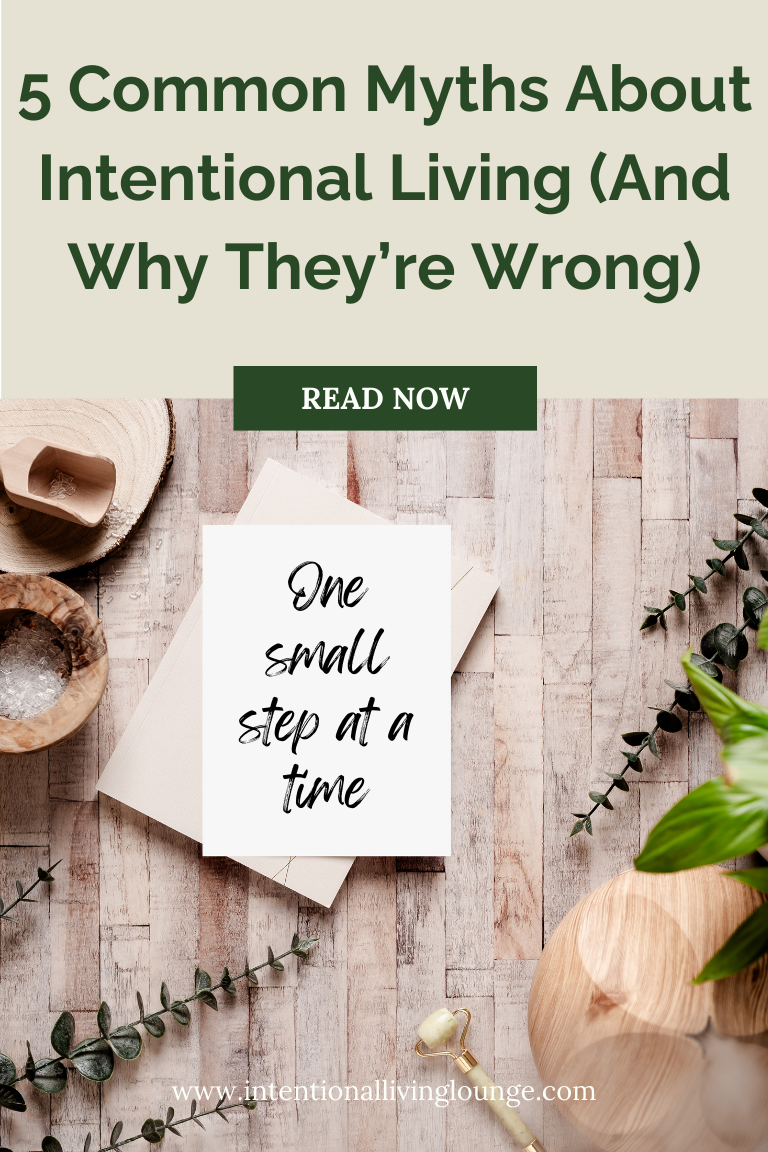5 Common Myths About Intentional Living (And Why They’re Wrong)
Intentional living is often misunderstood. Some think it's only for minimalists, while others believe it requires perfection or a rigid plan. In reality, intentional living is about making conscious choices that align with your values—without pressure or perfectionism.
If you've ever hesitated to embrace intentional living because of these misconceptions, let's debunk five of the most common myths together.
What Is Intentional Living?
Before we dive into the myths, let’s define intentional living. Simply put, intentional living means making deliberate choices that reflect what truly matters to you. It’s about aligning your actions, habits, and mindset with your values, rather than living on autopilot.
It doesn’t mean your life has to be rigidly planned out, nor does it require you to follow someone else’s version of a “perfect” lifestyle. Instead, it’s about cultivating awareness and making small, meaningful shifts that bring more alignment, purpose, and joy to your daily life.
Now, let's set the record straight on some common intentional living myths.
Myth 1: Intentional Living Requires Perfection
The Misconception
Many people believe that living intentionally means having everything figured out, following strict routines, and always making the "right" choices.
The Reality
Intentional living is not about perfection—it's about presence. Life is unpredictable, and striving for perfection only leads to stress and burnout. Instead of setting unrealistic expectations, focus on small intentional living practices that feel good to you.
Embracing imperfection is part of the journey. There will be days when you forget to journal, when your morning routine doesn’t go as planned, or when you make choices that don’t fully align with your intentions. And that’s okay. What matters is returning to what feels right for you, without self-judgment.
💡 Ask yourself: What’s one small choice I can make today that aligns with my values?
Myth 2: It’s Only for Minimalists
The Misconception
Because minimalism and intentional living often go hand in hand, some assume that to live intentionally, they must declutter everything and adopt a minimalist lifestyle.
The Reality
Intentional living is personal—it doesn’t mean you have to own less. It means choosing what adds value to your life, whether that’s a bookshelf full of beloved novels, a vibrant art collection, or a capsule wardrobe with just the essentials.
Minimalism can be a tool for intentional living, but it’s not the only way. The key is making intentional choices about what stays in your life—whether it’s physical belongings, relationships, commitments, or habits. Instead of focusing on what you should remove, shift your perspective to what you want to keep and why.
💡 Reflect: What in your life brings you true joy and meaning? How can you prioritise more of that?
Myth 3: Intentional Living Is Time-Consuming and Complicated
The Misconception
Some think that embracing intentional living requires hours of planning, reflection, and a complete lifestyle overhaul.
The Reality
Intentional living doesn’t have to be complicated! It’s about small, everyday decisions that create a life you love. You don’t need to set aside hours every day—simple mindful habits, like pausing before making a decision or setting an intention for the day, are enough.
Rather than viewing intentional living as something extra to add to your to-do list, think of it as a mindset shift that naturally integrates into your life. You’re likely already practicing it in some way—whether through the way you nourish yourself, the boundaries you set, or the moments you pause to appreciate your surroundings.
Start small:
✔ Set a daily intention over your morning coffee
✔ Spend 5 minutes journaling before bed
✔ Choose one thing to say "yes" to—and one to say "no" to
Remember, the goal is alignment, not overcomplication.
Myth 4: You Must Have Everything Figured Out
The Misconception
People often think intentional living means having a clear, detailed life plan and knowing exactly where you're headed.
The Reality
You don’t need all the answers to live intentionally! Intentional living is flexible, allowing you to adjust and grow along the way. Life is full of twists and turns, and that’s okay. What matters is checking in with yourself and making choices that feel right in the moment.
Many people delay making intentional choices because they’re waiting for clarity. But clarity often comes through action. Each small step you take—whether it’s trying a new habit, reflecting on your values, or making space for joy—helps you refine what truly matters to you.
🌱 Growth happens in the in-between moments, not just when you have a "perfect" plan.
Myth 5: Intentional Living Is a Solo Journey
The Misconception
Some believe intentional living is something you must do alone—deep self-reflection, journaling, and personal growth in isolation.
The Reality
While self-reflection is valuable, intentional living thrives in community. Surrounding yourself with like-minded people who support your journey makes all the difference. Whether it’s a friend, an online community, or a mentor, having connections can help you stay motivated and inspired.
Intentional conversations, shared experiences, and collective support can enhance your journey. You don’t have to navigate this path alone—connection is a powerful part of intentional living.
💡 Who in your life supports your journey? Reach out and share your thoughts with them today!
Final Thoughts: Embrace Your Unique Path
Intentional living is not about rules or restrictions—it’s about living in a way that feels aligned and fulfilling to you.
Give yourself permission to explore and redefine what intentional living means for you. Take one small step today, and trust that your journey will unfold in its own beautiful way.
Ready to Start Your Intentional Living Journey?
Get my free Notion guide, 10 Gentle Ways to Start Living Intentionally. Inside you’ll find simple practices and reflection prompts to help you slow down, reconnect with yourself, and create space for what truly matters.
